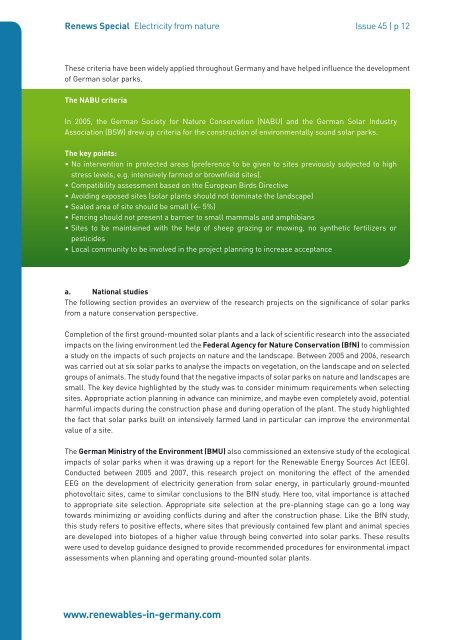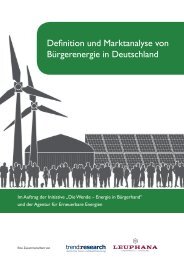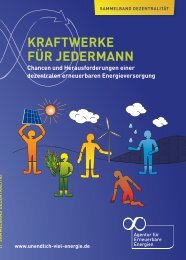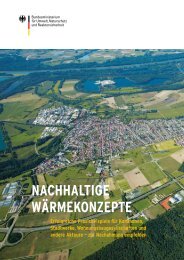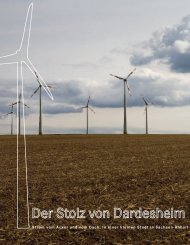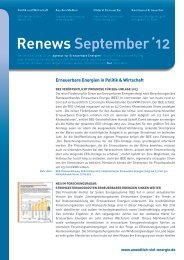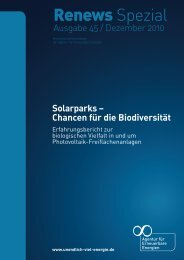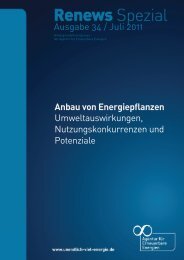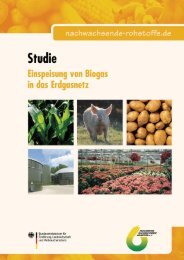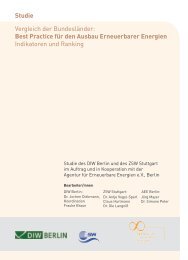Solar parks - Agentur für Erneuerbare Energien
Solar parks - Agentur für Erneuerbare Energien
Solar parks - Agentur für Erneuerbare Energien
You also want an ePaper? Increase the reach of your titles
YUMPU automatically turns print PDFs into web optimized ePapers that Google loves.
Renews Special Electricity from nature Issue 45 | p 12<br />
These criteria have been widely applied throughout Germany and have helped influence the development<br />
of German solar <strong>parks</strong>.<br />
The NABU criteria<br />
In 2005, the German Society for Nature Conservation (NABU) and the German <strong>Solar</strong> Industry<br />
Association (BSW) drew up criteria for the construction of environmentally sound solar <strong>parks</strong>.<br />
The key points:<br />
• No intervention in protected areas (preference to be given to sites previously subjected to high<br />
stress levels, e.g. intensively farmed or brownfield sites).<br />
• Compatibility assessment based on the European Birds Directive<br />
• Avoiding exposed sites (solar plants should not dominate the landscape)<br />
• Sealed area of site should be small (< 5%)<br />
• Fencing should not present a barrier to small mammals and amphibians<br />
• Sites to be maintained with the help of sheep grazing or mowing, no synthetic fertilizers or<br />
pesticides<br />
• Local community to be involved in the project planning to increase acceptance<br />
a. National studies<br />
The following section provides an overview of the research projects on the significance of solar <strong>parks</strong><br />
from a nature conservation perspective.<br />
Completion of the first ground-mounted solar plants and a lack of scientific research into the associated<br />
impacts on the living environment led the Federal Agency for Nature Conservation (BfN) to commission<br />
a study on the impacts of such projects on nature and the landscape. Between 2005 and 2006, research<br />
was carried out at six solar <strong>parks</strong> to analyse the impacts on vegetation, on the landscape and on selected<br />
groups of animals. The study found that the negative impacts of solar <strong>parks</strong> on nature and landscapes are<br />
small. The key device highlighted by the study was to consider minimum requirements when selecting<br />
sites. Appropriate action planning in advance can minimize, and maybe even completely avoid, potential<br />
harmful impacts during the construction phase and during operation of the plant. The study highlighted<br />
the fact that solar <strong>parks</strong> built on intensively farmed land in particular can improve the environmental<br />
value of a site.<br />
The German Ministry of the Environment (BMU) also commissioned an extensive study of the ecological<br />
impacts of solar <strong>parks</strong> when it was drawing up a report for the Renewable Energy Sources Act (EEG).<br />
Conducted between 2005 and 2007, this research project on monitoring the effect of the amended<br />
EEG on the development of electricity generation from solar energy, in particularly ground-mounted<br />
photovoltaic sites, came to similar conclusions to the BfN study. Here too, vital importance is attached<br />
to appropriate site selection. Appropriate site selection at the pre-planning stage can go a long way<br />
towards minimizing or avoiding conflicts during and after the construction phase. Like the BfN study,<br />
this study refers to positive effects, where sites that previously contained few plant and animal species<br />
are developed into biotopes of a higher value through being converted into solar <strong>parks</strong>. These results<br />
were used to develop guidance designed to provide recommended procedures for environmental impact<br />
assessments when planning and operating ground-mounted solar plants.<br />
p 13 | Issue 45 Renews Special <strong>Solar</strong> <strong>parks</strong> – Opportunities for Biodiversity<br />
In 2010, following another project, the German Ministry of the Environment published numerous<br />
recommendations for environmentally friendly exploitation of solar energy in an online information<br />
database of nature protection standards for renewable energy sources (www.naturschutzstandardserneuerbarer-energien.de).<br />
The dedicated website presents structured background information on the<br />
possible conflicts of interest with nature conservation and identifies possible solutions.<br />
b. Local projects<br />
Conservation issues are investigated and studied in greater detail as part of the planning and approval<br />
procedures for individual solar park projects. During local planning approval for solar <strong>parks</strong>, local<br />
authorities often commission long-term monitoring programmes. Examples include the monitoring<br />
programmes at the Lieberose (Brandenburg), Schneeberger Hof (Rhineland-Palatinate), Tegel (Berlin)<br />
and Waldpolenz (Saxony) solar <strong>parks</strong>. The majority of these are monitoring impacts on birdlife. There is<br />
also a monitoring programme on the impact on vegetation and one on grasshoppers.<br />
c. International research on biodiversity and solar <strong>parks</strong><br />
Many of the world’s largest solar <strong>parks</strong> are being built in Canada, Italy, Spain, France and the USA, with<br />
Germany continuing to play a leading role. German research aimed at achieving a better understanding<br />
of the ecological impacts of solar <strong>parks</strong> has been met with a particularly high level of international<br />
interest.<br />
The international debate is still fairly unstructured.<br />
Numerous examples of local<br />
and national approaches focusing on<br />
conservation in solar <strong>parks</strong> show that the<br />
topic is of increasing international importance.<br />
Developments in France provide a good<br />
example. In France there is a policy to<br />
link photovoltaic development to environmental<br />
standards. The French<br />
Ministry of Sustainable Development is<br />
developing guidelines that will include<br />
the environmental impacts of solar<br />
<strong>parks</strong>. The guidelines highlight in detail<br />
measures pertaining to site selection,<br />
environmental reports, the involvement of<br />
local environmental groups and possible<br />
conditions and compensatory measures.<br />
The Comité de Liaison Energies<br />
Renouvelables (CLER) has also joined<br />
forces with other environmental organisations<br />
like Greenpeace, the WWF and<br />
Birdlife International to draw up a list of<br />
criteria similar to the NABU criteria in<br />
Germany.<br />
Unlike intensively farmed land, solar <strong>parks</strong> provide space for species-rich grassland<br />
(Photo: Gehrlicher <strong>Solar</strong> AG)


